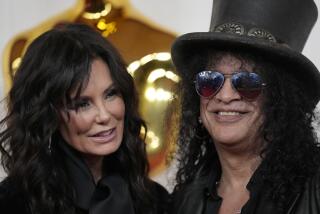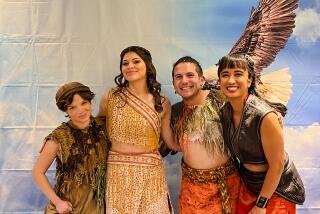American Photography as Seen From Japan : AMERICAN CONTEMPORARY PHOTOGRAPHY<i> (Min Gallery & Studio, U.S. Distributor: $20-$30; multivolume series) </i>
The theory that the Pacific Rim is overtaking the Atlantic Seaboard as the premier center of international power has attracted fervent believers among visual-arts aficionados in Los Angeles. It takes imagination to write off New York as an anachronism, but visionary Angelenos who are weary of having their city ignored as an idiot step-child of America’s art mecca see California’s cultural growth and its proximity to a phenomenally wealthy Japan as the key to a new order. Let Easterners cling to Europe, they say. We have all of Asia just across the Pacific.
Such arguments make California’s cultural dealings with Asians seem self-serving, but there’s no denying an increased level of sophistication in the art that now crosses the Pacific. Consider the Min Gallery and Studio in Tokyo. Established about 1 1/2 years ago by Min Shirota, who formerly studied art and photography in San Francisco, the gallery has launched a two-year program of exhibitions of “American Contemporary Photography.” Members of the Pacific Rim School should love it because all the “Americans” live on the West Coast or established their reputations here.
Min’s exhibitions introduce the artists to Japan in what is said to be the only Toyko gallery devoted exclusively to contemporary photography. A remarkable development, but what further distinguishes it is that a catalogue with 40 color or duotone plates and bilingual text is published for each exhibition.
The result, still in process, is a 25-volume series, American Contemporary Photography (Min Gallery and Studio, U.S. distributor: 2611 Euclid St., Studio D, Santa Monica 90405, (213) 450-7722; volumes individually priced, from $20 to $30).
Fourteen books have been released so far. One covers a group show; the others are monographs on Barry Brukoff, Jo Ann Callis, Morrie Camhi, John Divola, Robbert Flick, Anthony Friedkin, Robert Heinecken, Michael Kenna, Robert Glenn Ketchum, Grant Mudford, collaborators Patrick Nagatani and Andree Tracey, Catherine Wagner and Henry Wessel.
The remaining 11 volumes, to be published next year, will feature Jerry Burchfield, Jack Butler, Linda Connor, Eileen Cowin, Judy Dater, Robert Dawson, Mark Johnstone, Richard Misrach, Kenda North, Susan Rankaitis and Jack Welpott.
A predictable roster, but the artists are deserving of international exposure and their work is sufficiently varied to compose a satisfying survey. While containing no hard-core street photography or photojournalism, the series’ broad spectrum includes artists who interpret ready-made subject matter as well as those who construct sets in their studios.
The photographers who go out into the world produce images ranging from the starkly mechanical to the naturally casual and irrepressibly human. Mudford, for example, focuses on the rhythms of industrial sites--stripes of aluminum siding, patterns of bricks, textures of coal--in pristine black-and-white prints that refine mundane subjects and elevate them to a level of formal dignity. Wagner’s views of deserted, much lived-in classrooms reveal ungainly places that are austere but oddly comforting--haunted as they are by ghosts of dedicated teachers and traces of new-found knowledge.
Working in the rather unfashionable terrain of landscape and allying himself with 19th-Century Romanticism, Ketchum presents ravishing tapestries of nature, so infinitely detailed as to be unknowable. Instead of cropping trees, he gives us forests with all their leaves and layers of patterns. Adopting a more contemporary approach to landscape, Flick talks about ways of seeing as he presents serial views of cornfields and parched canyons.
Among the social observers, Wessel finds humor, pathos and camaraderie in the backsides of people; Friedkin skewers bizarre aspects of Hollywood and treats surfing as a cult that’s both mystical and erotic. Warm, gruff and completely forgiving of human imperfections, Camhi’s engaging portraits of middle-age, working-class folks are masterpieces of the genre.
Most of the other artists fabricate situations to be photographed. Nagatani and Tracey, who have nuclear warfare on their minds, build elaborate sets for large-format Polaroids that segue disconcertingly between reality and fantasy. In a well-known and very successful series, Divola spent months shooting a disintegrating beach house that served as a practice site for firefighters. He also used the house as a canvas, spraying designs on its walls and purposefully smudging boundaries between painting and photography.
Television images and magazine advertisements are among Heinecken’s raw materials in photo/text works that criticize a consumer society but often ring hollow. A 10-year review of Jo Ann Callis’ work confirms her position as an artist of persistently disturbing vision. Whether photographing sunbathers as black holes or hardware as clinical weaponry, she twists perceptions in unforgettable images.
Unfortunately the text accompanying most of these volumes fails to live up to the quality of the pictures. One-page essays by photographer and critic Mark Johnstone are so flawed that they detract from the laudable project. Whimsical punctuation and grammatical confusion must be the work of a proofreader with a rudimentary grasp of English. Editing is equally slipshod, permitting redundancies (“various disparate,” “increased proliferation,” “condemning indictment”), rampant use of boldface type, unnecessary underlining and awkward sentence structure.
But Johnstone himself must take responsibility for his sweeping theoretical content and disjointed style. Intellectual posturing is not the worst of the problem. Writing like a student who is afraid of leaving out something important, he either makes lists or avoids the work entirely. Determined to be high-minded while straining to establish a historical context for the artists, he’s at a dead loss with a humanist like Camhi. After floundering for several paragraphs, Johnstone announces, in effect, that he hasn’t talked about any of Camhi’s images because there’s too much to be said about them--and to mention one would be to deprive others of attention.
It comes as a relief, then, to open the book on Wessel and find an unpretentious interview with an artist who says his task is “to describe existing light” and that he takes pictures because it’s a thrill to connect with the world while letting “your eyes get ahead of your brain.”
More to Read
The biggest entertainment stories
Get our big stories about Hollywood, film, television, music, arts, culture and more right in your inbox as soon as they publish.
You may occasionally receive promotional content from the Los Angeles Times.






